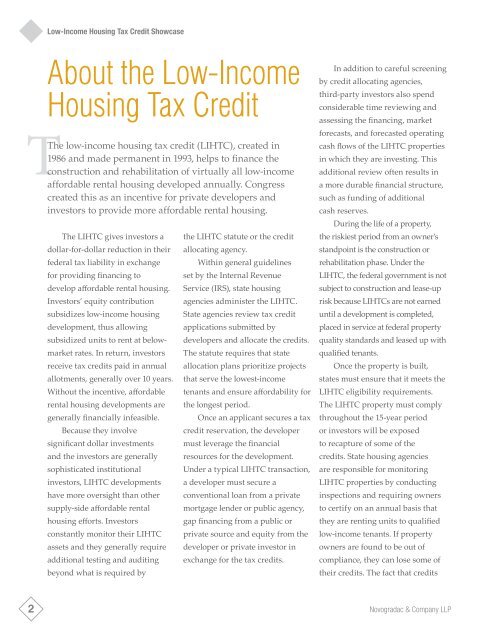LOW-INCOME HOUSING TAX CREDIT SHOWCASE
novogradac_lihtc_showcase
novogradac_lihtc_showcase
You also want an ePaper? Increase the reach of your titles
YUMPU automatically turns print PDFs into web optimized ePapers that Google loves.
Low-Income Housing Tax Credit Showcase<br />
T<br />
About the Low-Income<br />
Housing Tax Credit<br />
The low-income housing tax credit (LIHTC), created in<br />
1986 and made permanent in 1993, helps to finance the<br />
construction and rehabilitation of virtually all low-income<br />
affordable rental housing developed annually. Congress<br />
created this as an incentive for private developers and<br />
investors to provide more affordable rental housing.<br />
The LIHTC gives investors a<br />
dollar-for-dollar reduction in their<br />
federal tax liability in exchange<br />
for providing financing to<br />
develop affordable rental housing.<br />
Investors’ equity contribution<br />
subsidizes low-income housing<br />
development, thus allowing<br />
subsidized units to rent at belowmarket<br />
rates. In return, investors<br />
receive tax credits paid in annual<br />
allotments, generally over 10 years.<br />
Without the incentive, affordable<br />
rental housing developments are<br />
generally financially infeasible.<br />
Because they involve<br />
significant dollar investments<br />
and the investors are generally<br />
sophisticated institutional<br />
investors, LIHTC developments<br />
have more oversight than other<br />
supply-side affordable rental<br />
housing efforts. Investors<br />
constantly monitor their LIHTC<br />
assets and they generally require<br />
additional testing and auditing<br />
beyond what is required by<br />
the LIHTC statute or the credit<br />
allocating agency.<br />
Within general guidelines<br />
set by the Internal Revenue<br />
Service (IRS), state housing<br />
agencies administer the LIHTC.<br />
State agencies review tax credit<br />
applications submitted by<br />
developers and allocate the credits.<br />
The statute requires that state<br />
allocation plans prioritize projects<br />
that serve the lowest-income<br />
tenants and ensure affordability for<br />
the longest period.<br />
Once an applicant secures a tax<br />
credit reservation, the developer<br />
must leverage the financial<br />
resources for the development.<br />
Under a typical LIHTC transaction,<br />
a developer must secure a<br />
conventional loan from a private<br />
mortgage lender or public agency,<br />
gap financing from a public or<br />
private source and equity from the<br />
developer or private investor in<br />
exchange for the tax credits.<br />
In addition to careful screening<br />
by credit allocating agencies,<br />
third-party investors also spend<br />
considerable time reviewing and<br />
assessing the financing, market<br />
forecasts, and forecasted operating<br />
cash flows of the LIHTC properties<br />
in which they are investing. This<br />
additional review often results in<br />
a more durable financial structure,<br />
such as funding of additional<br />
cash reserves.<br />
During the life of a property,<br />
the riskiest period from an owner’s<br />
standpoint is the construction or<br />
rehabilitation phase. Under the<br />
LIHTC, the federal government is not<br />
subject to construction and lease-up<br />
risk because LIHTCs are not earned<br />
until a development is completed,<br />
placed in service at federal property<br />
quality standards and leased up with<br />
qualified tenants.<br />
Once the property is built,<br />
states must ensure that it meets the<br />
LIHTC eligibility requirements.<br />
The LIHTC property must comply<br />
throughout the 15-year period<br />
or investors will be exposed<br />
to recapture of some of the<br />
credits. State housing agencies<br />
are responsible for monitoring<br />
LIHTC properties by conducting<br />
inspections and requiring owners<br />
to certify on an annual basis that<br />
they are renting units to qualified<br />
low-income tenants. If property<br />
owners are found to be out of<br />
compliance, they can lose some of<br />
their credits. The fact that credits<br />
2 Novogradac & Company LLP


